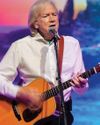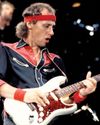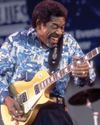
GT: What is it about guitar instrumentals that appeals to you?
VM: I love playing and writing, and instrumentals seem like a direct and immediate way for me to express myself. I learned to improvise by recording chord progressions that I made up, and then playing over them every day. So without really being aware that I was writing instrumentals, I was well down the path when my intention was really just to work on my playing. Hearing Jeff Beck, Larry Carlton, Al Di Meola, and Carlos Santana opened up all kinds of doors in my mind.
GT: What can an instrumental provide a listener that a vocal song can’t?
VM: An instrumental can provide a more intricate melody because there are less limitations than with a voice. I don’t actually prefer one over the other, a good song is a good song. So I guess the best of both worlds is a great vocal song with some awesome guitar melodies and solos in there too. You could maybe say that since an instrumental song has no lyrics, it can leave more to the imagination whereas a vocal song clearly tells you what it is about.
GT: Any tendencies with instrumentals that you like to embrace or avoid?
VM: I mostly aim to avoid things I’ve done too many times before. If I become aware that I have done something similar, it kind of kills the spirit for me. So ignorance is bliss in a way. Having said that, there are a million great songs with the same chord changes. But I do get a big thrill when I’m writing and I do something I haven’t done before.
GT: Is a typical song structure always relevant for an instrumental?
この記事は Guitar Techniques の September 2023 版に掲載されています。
7 日間の Magzter GOLD 無料トライアルを開始して、何千もの厳選されたプレミアム ストーリー、9,000 以上の雑誌や新聞にアクセスしてください。
すでに購読者です ? サインイン
この記事は Guitar Techniques の September 2023 版に掲載されています。
7 日間の Magzter GOLD 無料トライアルを開始して、何千もの厳選されたプレミアム ストーリー、9,000 以上の雑誌や新聞にアクセスしてください。
すでに購読者です? サインイン

THE MOODY BLUES
This month Stuart Ryan delves into the picking style of this British prog legend whose acoustic guitar has powered many a Moody Blues song.

WAYNE KRANTZ
This issue Nick Mellor provides an insight into this brilliant jazz stylist, focusing on his approach to improvising over static chords.

OPEN G TUNING
Open tunings are great fun and can help create exciting new ideas. Simon Barnard shows how to incorporate open G tuning into your playing.

RODRIGO GOUVEIA
Last month we featured Mateus Asato, and mentioned the importance of the neo-soul style in his playing. Here we turn to his fellow Brazilian, the master of neo-soul fusion.

MARK KNOPFLER
Our topic this month is a master craftsman as both guitar player and songwriter. His style is unique and his influence spreads far and wide.

U2
Martin Cooper checks out the chiming pedal delay tones of this stadium-filling band from Dublin, Ireland, and guitarist The Edge.

LUTHER ALLISON
It’s blues with a touch of soul this month, as David Gerrish explores the dynamic, expressive style of an often overlooked Chicago bluesman.

JOHANN KASPAR MERTZ Capriccio
This month Declan Zapala explores the music of Austria at the turn of the Romantic period with a fiery caprice to level up your fingers and unlock your inner virtuoso.

THE CROSSROADS Michael Landau
John Wheatcroft explores the playing of a session ace _ and blazing blues-rock maestro who graces the top-flight m band of singer-songwriting legend, James Taylor.

VIDEO MASTERCLASS Troy Redfern
This month GT welcomes this slide guitar virtuoso. If you've been wanting to take your slide playing to the next level then this is one's for you. With Jon Bishop.